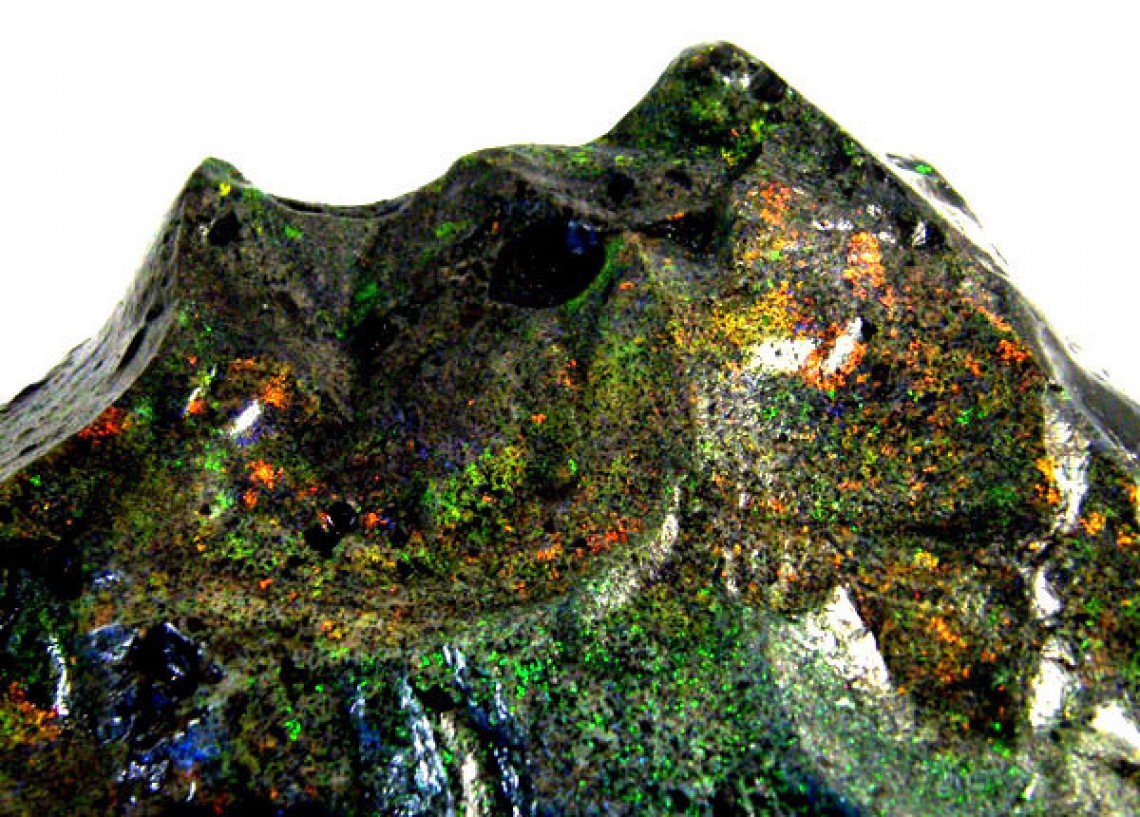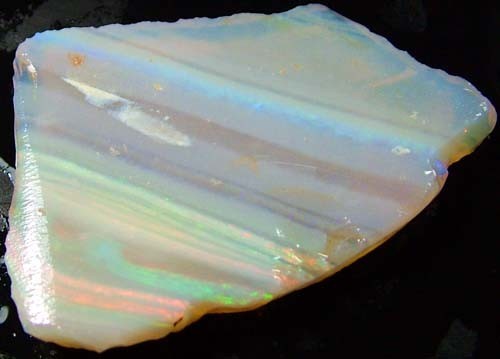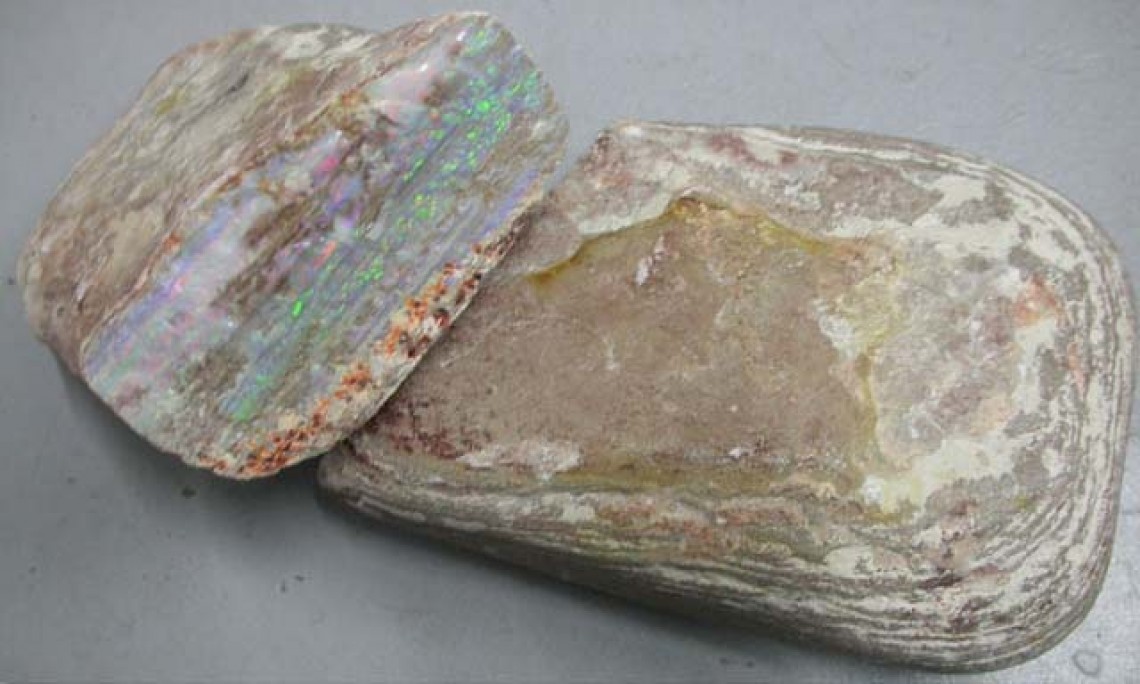
安达穆卡蛋白石的历史及其处理方法

[阅读时间:10分钟]
20世纪30年代,南澳大利亚的安达穆卡(Andamooka)首次发现了蛋白石。第一块安达穆卡蛋白石是由萨姆·布鲁克斯(Sam Brookes)和罗伊·谢泼德(Roy Sheppard)发现的。当时他们正遭遇雷雨,躲在一棵树下,一块漂亮的石头映入眼帘。此后,一些较小的矿藏也相继被发现,包括1930年的兰比纳(Lambina)矿藏和1947年的斯图尔特溪(Stuart Creek)矿藏。安达穆卡的蛋白石赋存于薄薄的海相“斗牛犬页岩”(Bulldog Shale)中,该页岩是早白垩世马里亚群(Marree Subgroup)的重要组成部分。
概括
安达穆卡是澳大利亚已知最古老的蛋白石矿区之一。
安达穆卡出产的蛋白石曾被用于女王的珠宝制作中。
安多莫卡蛋白石可以用糖处理,使其变黑,并改善蛋白石的变彩效果。

著名的安达穆卡蛋白石
安达莫卡蛋白石也被称为“女王的蛋白石”。它于1954年被切割并镶嵌在一条18K钯金项链上。这条项链在伊丽莎白二世女王首次正式访问澳大利亚时被赠予她。如今,这条项链和耳环被视为伊丽莎白二世女王珍贵王冠珠宝的重要组成部分。这颗蛋白石最终重达203克拉。

安达穆卡矿区于1930年被发现,被认为是澳大利亚最著名的蛋白石矿区之一。这里出产了一些最精美的蛋白石,例如上文提到的“安达穆卡基质蛋白石”(也被称为“女王蛋白石”)。安达穆卡(Andamooka)一词源于原住民语,意为“大水潭”。它位于阿德莱德以北600公里处,是澳大利亚唯一一座所有街道都没有名字的城市。

安达穆卡蛋白石处理
安达莫卡蛋白石矿以出产浅色蛋白石而闻名,这种蛋白石呈白色,晶莹剔透,有时也被称为“牛奶”蛋白石。
基质蛋白石是一种可渗透蛋白石,产自南澳大利亚的安达穆卡。安达穆卡也出产多种砾石蛋白石。周边地区的大部分岩石是石英岩,因此蛋白石有时会形成于这种坚硬岩石的缝隙中。这些蛋白石被称为“彩绘女士”。

安达莫卡基质蛋白石通常会经过处理以改善其颜色,即使用黑碳形成黑色体。这种处理方法是将化学试剂涂抹在整块石头上。刚从地里挖出来的安达莫卡基质蛋白石看起来可能比较糊状,但经过碳染色处理后,最终会呈现出更具吸引力的蛋白石外观。
经过彻底处理后,这种蛋白石被称为安达莫卡处理基质蛋白石。处理方法通常是先用高浓度糖水溶液浸泡,然后在浓硫酸浴中慢煮。糖分渗入石灰岩基质,硫酸将其煮沸,使蛋白石周围的白色糖分转化为黑色碳。最终,深色基质包裹住蛋白石,使其不再衍射光线。一些矿工将原石盗走,冒充闪电岭黑蛋白石在海外出售。骗局败露后,一度无人问津处理过的基质蛋白石。但事实上,顶级宝石所具有的非凡色彩和浓郁的黑色基质,正是闪电岭黑蛋白石闻名遐迩的特质。处理这些基质蛋白石的方法相对简单。
 有时会使用环氧玻璃树脂来赋予石头美丽的光泽。你可以在这里找到它。
有时会使用环氧玻璃树脂来赋予石头美丽的光泽。你可以在这里找到它。

安达穆卡恐龙骨骼
安达莫卡地区曾发现恐龙化石和骨骼,其中许多现藏于博物馆。澳大利亚恐龙的年龄在1亿至2.4亿年前,属于侏罗纪和白垩纪时期。许多国家都发现了恐龙骨骼,但只有在澳大利亚才发现了蛋白石化的恐龙化石。
安达穆卡蛋白石价格
基质蛋白石的价格通常比较合理,这与真正的黑蛋白石截然不同。买家在购买时应该注意,从一些蛋白石经销商处购买的究竟是真正的黑蛋白石还是安达莫卡基质蛋白石。 
如何处理安达莫卡矩阵蛋白石
所用设备非常简易。加热时,可以使用带温控器的旧电煎锅。切记不要过度加热蛋白石,因为过热会导致其破裂。
将 1 杯糖(白糖或红糖似乎没有区别)放入耐热玻璃碗或其他耐热碗中,加入等量的水,加热至糖溶解。
加热时,将煎锅调至中档火力。可以将耐热玻璃碗直接放在煎锅上。
在处理原石蛋白石之前,需要对其进行切割、塑形和打磨,但无需抛光。应使用温和加热的方式彻底干燥蛋白石,以去除宝石细小孔隙中的水分。避免用手指触摸宝石,因为手指上的油脂会影响处理效果。
然后将石头放入糖浆中,煮8小时以上。煮制时间多少只能大概估计,取决于石头的孔隙率。孔隙率高的石头比孔隙率低的石头吸收糖浆的速度要快得多。我不知道如何准确估算所需时间,但8小时似乎是个不错的开始。
煮熟后让它们冷却。如果由于烹煮过程中水分蒸发导致糖水过稠,可能需要在此阶段添加一些水。
下一阶段非常危险,因为它涉及到使用高浓度硫酸。硫酸具有极强的腐蚀性,而且产生的烟雾也十分危险。
使用从化学品供应商处购买的93%硫酸。
取少量食材放入耐热玻璃碗中,然后将碗放入煎锅中。煎锅放在通风良好的棚子里。
将酸倒入碗中时,建议戴上橡胶手套和护目镜,因为酸溅到皮肤上会造成严重灼伤,务必小心。切勿将酸倒入水中,否则会发生剧烈反应,酸液可能会溅到身上。最好也戴上口罩。
然后,用塑料镊子(不要用金属镊子,因为金属镊子会与酸发生反应)小心地将石头从糖溶液中取出,待多余的糖溶液滴落后,再小心地放入酸中。此时不要擦拭石头。将石头放入温热的酸中煮两个小时以上。此时,石头会变色。用塑料镊子小心地取出石头,放入另一个装有稀糖溶液或小苏打溶液的碗中。这样做是为了中和酸。
几分钟后即可欣赏,但还需要进行最后的抛光。趁着蛋白石还湿润,你会看到它发生的惊人变化。蛋白石的色彩会清晰地展现出来。
如果基质相当致密,现在应该可以抛光宝石了。最好不要使用氧化铈或氧化锡,因为抛光剂可能会渗入孔隙,形成细小的白点,从而损坏表面。抛光时,请使用带有 50,000 目金刚石的皮革抛光盘。
需要格外小心,不要施加过大的压力,因为这会产生大量热量,并可能导致石材开裂。孔隙率较高的石材可能根本无法抛光。如果出现这种情况,可以在表面涂覆液态玻璃,以获得高度抛光的表面。我将在另一篇文章中讨论这种处理方法。
别忘了小心处理酸液。将酸液缓慢倒入水中,待其高度稀释后,将其埋入花园中。切勿将水直接倒入酸液中,否则酸液会飞溅,容易溅到身上造成伤害。如果发生这种情况,请立即用大量清水冲洗受影响的区域。如果您对这种方法或其他方法有任何意见或建议,欢迎留言。这种方法对我有效,我得到了一些非常漂亮的石头,它们看起来很像优质的黑欧泊,而且价格非常低廉。
购买安达穆卡蛋白石
搜索Opal Encyclopedia
最新的文章
文章分类
All there is to know about Opals including Black Opals, Ethiopian Opals & Boulder Opal
14文章数
Check out our fascinating information and articles on all things amazing in the Opal world
41文章数



